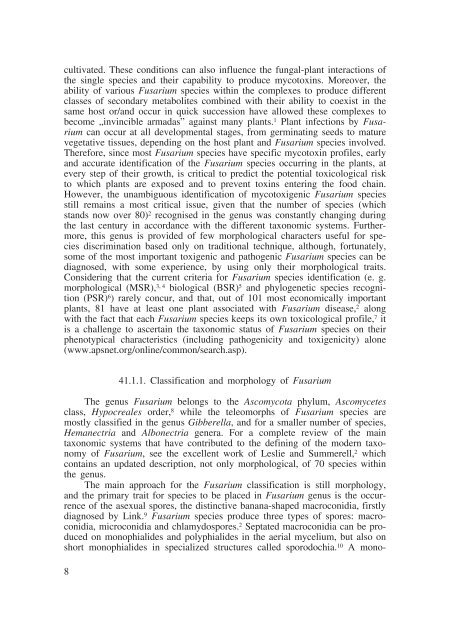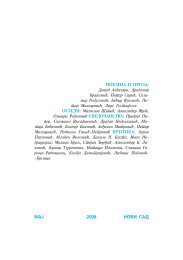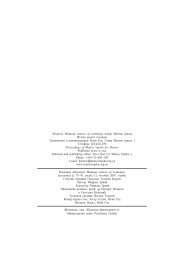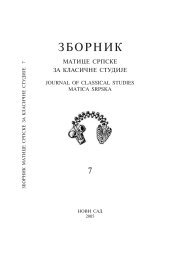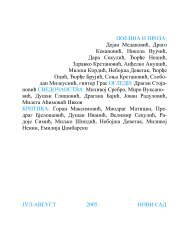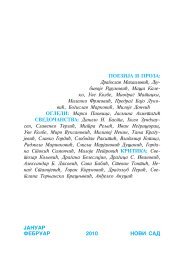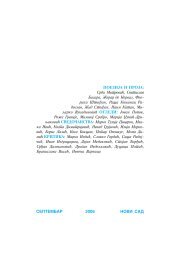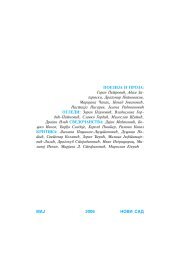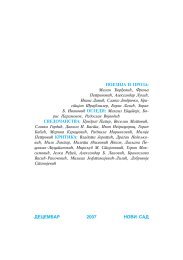ЗБОРНИК - Matica srpska
ЗБОРНИК - Matica srpska
ЗБОРНИК - Matica srpska
Create successful ePaper yourself
Turn your PDF publications into a flip-book with our unique Google optimized e-Paper software.
cultivated. These conditions can also influence the fungal-plant interactions of<br />
the single species and their capability to produce mycotoxins. Moreover, the<br />
ability of various Fusarium species within the complexes to produce different<br />
classes of secondary metabolites combined with their ability to coexist in the<br />
same host or/and occur in quick succession have allowed these complexes to<br />
become „invincible armadas" against many plants. 1 Plant infections by Fusarium<br />
can occur at all developmental stages, from germinating seeds to mature<br />
vegetative tissues, depending on the host plant and Fusarium species involved.<br />
Therefore, since most Fusarium species have specific mycotoxin profiles, early<br />
and accurate identification of the Fusarium species occurring in the plants, at<br />
every step of their growth, is critical to predict the potential toxicological risk<br />
to which plants are exposed and to prevent toxins entering the food chain.<br />
However, the unambiguous identification of mycotoxigenic Fusarium species<br />
still remains a most critical issue, given that the number of species (which<br />
stands now over 80) 2 recognised in the genus was constantly changing during<br />
the last century in accordance with the different taxonomic systems. Furthermore,<br />
this genus is provided of few morphological characters useful for species<br />
discrimination based only on traditional technique, although, fortunately,<br />
some of the most important toxigenic and pathogenic Fusarium species can be<br />
diagnosed, with some experience, by using only their morphological traits.<br />
Considering that the current criteria for Fusarium species identification (e. g.<br />
morphological (MSR), 3, 4 biological (BSR) 5 and phylogenetic species recognition<br />
(PSR) 6 ) rarely concur, and that, out of 101 most economically important<br />
plants, 81 have at least one plant associated with Fusarium disease, 2 along<br />
with the fact that each Fusarium species keeps its own toxicological profile, 7 it<br />
is a challenge to ascertain the taxonomic status of Fusarium species on their<br />
phenotypical characteristics (including pathogenicity and toxigenicity) alone<br />
(www.apsnet.org/online/common/search.asp).<br />
41.1.1. Classification and morphology of Fusarium<br />
The genus Fusarium belongs to the Ascomycota phylum, Ascomycetes<br />
class, Hypocreales order, 8 while the teleomorphs of Fusarium species are<br />
mostly classified in the genus Gibberella, and for a smaller number of species,<br />
Hemanectria and Albonectria genera. For a complete review of the main<br />
taxonomic systems that have contributed to the defining of the modern taxonomy<br />
of Fusarium, see the excellent work of Leslie and Summerell, 2 which<br />
contains an updated description, not only morphological, of 70 species within<br />
the genus.<br />
The main approach for the Fusarium classification is still morphology,<br />
and the primary trait for species to be placed in Fusarium genus is the occurrence<br />
of the asexual spores, the distinctive banana-shaped macroconidia, firstly<br />
diagnosed by Link. 9 Fusarium species produce three types of spores: macroconidia,<br />
microconidia and chlamydospores. 2 Septated macroconidia can be produced<br />
on monophialides and polyphialides in the aerial mycelium, but also on<br />
short monophialides in specialized structures called sporodochia. 10 A mono-<br />
8


